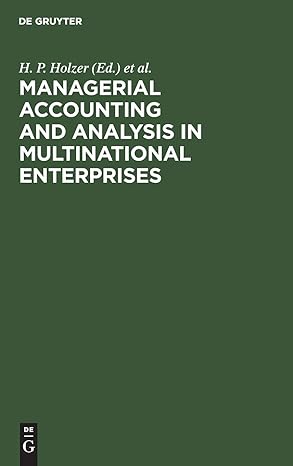Question
1) General guideline, transfer pricing. The Slate Company manufactures and sells television sets. Its assembly division (AD) buys television screens from the screen division (SD)
1) General guideline, transfer pricing. The Slate Company manufactures and sells television sets. Its assembly division (AD) buys television screens from the screen division (SD) and assembles the TV sets. The SD, which is operating at capacity, incurs an incremental manufacturing cost of $65 per screen. The SD can sell all its output to the outside market at a price of $100 per screen, after incurring a variable marketing and distribution cost of $8 per screen. If the AD purchases screens from outside suppliers at a price of $100 per screen, it will incur a variable purchasing cost of $7 per screen. Slate's division managers can act autonomously to maximize their own division's operating income.
Now suppose that the SD can sell only 70% of its output capacity of 20,000 screens per month on the open market. Capacity cannot be reduced in the short run. The AD can assemble and sell more than 20,000 TV sets per month.
What is the minimum transfer price at which the SD manager would be willing to sell screens to the AD
a) 0
b) 65
c) 100
d) 107
e) 27
2)Hamilton Corp. is a reinsurance and financial services company. Hamilton strongly believes in evaluating the performance of its stand-alone divisions using financial metrics such as ROI and residual income. For the year ended December 31, 2017, Hamiltons CFO received the following information about the performance of the property/casualty division:
Sales revenues
$900,000
Operating income
225,000
Total assets
1,500,000
Current liabilities
300,000
Debt (interest rate: 5%)
400,000
Common equity (book value)
500,000
For the purposes of divisional performance evaluation, Hamilton defines investment as total assets and income as operating income (that is, income before interest and taxes). The firm pays a flat rate of 25% in taxes on its income.
What was net operating profit after taxes using EVA approach ?
$153,750
$156,750
$152,750
$168,750
$143,111
Step by Step Solution
There are 3 Steps involved in it
Step: 1

Get Instant Access to Expert-Tailored Solutions
See step-by-step solutions with expert insights and AI powered tools for academic success
Step: 2

Step: 3

Ace Your Homework with AI
Get the answers you need in no time with our AI-driven, step-by-step assistance
Get Started


